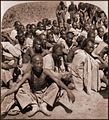File:Boxer Prisoners Captured By 6th US Cavalry, Tientsin, China (1901) Underwood & Co (RESTORED) (4072872709).jpg

原始檔案 (1,262 × 1,392 像素,檔案大小:292 KB,MIME 類型:image/jpeg)
摘要
| 描述Boxer Prisoners Captured By 6th US Cavalry, Tientsin, China (1901) Underwood & Co (RESTORED) (4072872709).jpg |
Entitled: Some of China's trouble-makers - "Boxer" prisoners captured and brought in by 6th U.S. Cavalry, Tientsin, China [1901] Underwood & Co. [RESTORED] The picture was retouched to eliminate spotting and obvious defects; tonal range was expanded to reveal better details in the shadows; cropped as single image from right side of double imaged stereoscope print, and mildly sepia toned. The title is not accurate, as it is now believed that most of the supposed Boxer prisoners caught by Foreign troops were just innocent bystanders. Nonetheless, the US Library of Congress, where this historic image resides (under Reproduction Number LC-USZ62-68811), maintains the original title as it was historically written or described by the person(s) that originally made or produced the photograph. Original was taken by a photographer employed by the Underwood & Underwood Company. Underwood was one of several companies at the time, whose business purpose was to send photographers to all parts of the world to photographically record interesting events in the hopes of selling the pictures to domestic customers. The double imaged pictures were recorded with a special stereo camera; that is, a camera fitted with two lenses side by side. This optical arrangement mimicked the natural and mildly divergent views of each eye that is necessary for human depth perception. When the resultant processed image was placed at a correct distance from both eyes (using a standardized picture holder - viewer), it reproduced a false sense of depth perception. This effectively made the image seem three dimensional and slightly more authentic, giving the viewer a feeling that they were witnessing the actual real life event. Thousands of these stereoscopic photos were sold in their day, and many may still be found tucked away in the old forgotten boxes of a grandparent's basement or attic. Additionally, black and white photography at that time was limited in terms of how the film perceived the colors of the spectrum. Most films were termed orthochromatic, that is, the film was sensitive to the Blue and Greens but was a poor recorder of the Red end of the spectrum. Thus, the skin tone of darker Asians, especially those worked in the sun and were well tanned, tended to be rendered much darker. This gave many Chinese in early black and white photographs darker skin tones, making them appear more African than Asian. In later years, this phenomenon faded with the introduction of Panchromatic films; that is, film with emulsions that were equally sensitized to all the colors of the spectrum. This picture is a cue to a lot of history. Taken about one year after the suppression of the "Boxers" (as the Chinese participants were known to the foreigners) these men were reportedly captured from the surrounding areas outside of Tientsin, China. The foreign powers had sought to purge and punish the responsible participants that had brought about the rebellion the year before (in 1900). Knowing little and caring even less about the locals, the foreign troops stated mission was to raid supposed Boxer stronghold villages to capture criminal Boxer participants that were still at large and to bring them to justice. However, what they effectively engaged in was pillaging, rape, and razing operations; essentially reprisals for the Chinese wounding of the Europeans. Prisoners that were not killed outright were brought back into the city for show trials and public executions. These expeditions snared mostly farmers, field hands, and otherwise uninvolved and innocent local Chinese. Under agreement with a Qing government that was more worried with preserving its monarchy than to concern itself with jurisprudence, thousands of Chinese were thus rounded up and executed by either western military or an acquiescing Chinese imperial authority. This heinous treatment of the Chinese populace by foreigners drove home the point that the Qing were no longer able to control China, and within this perceived power vacuum, the stage for China's transformation into a republic was ultimately set. |
| 日期 | |
| 來源 | Boxer Prisoners Captured By 6th US Cavalry, Tientsin, China [1901] Underwood & Co [RESTORED] |
| 作者 | ralph repo |
授權條款
- 您可以自由:
- 分享 – 複製、發佈和傳播本作品
- 重新修改 – 創作演繹作品
- 惟需遵照下列條件:
- 姓名標示 – 您必須指名出正確的製作者,和提供授權條款的連結,以及表示是否有對內容上做出變更。您可以用任何合理的方式來行動,但不得以任何方式表明授權條款是對您許可或是由您所使用。
| 這幅圖片原始出處為Flickr的https://www.flickr.com/photos/34607376@N08/4072872709 ,作者為ralphrepo 。經機器人FlickreviewR在2014年6月16日審查後確定為採用cc-by-2.0的協議授權使用。 |
2014年6月16日
說明
在此檔案描寫的項目
描繪內容
Manchu queue 英文
沒有維基數據項目的某些值
創用CC姓名標示2.0通用版 繁體中文 (已轉換拼寫)
3 11 2009
image/jpeg
298,995 位元組
1,392 像素
1,262 像素
檔案歷史
點選日期/時間以檢視該時間的檔案版本。
| 日期/時間 | 縮圖 | 尺寸 | 使用者 | 備註 | |
|---|---|---|---|---|---|
| 目前 | 2014年6月16日 (一) 01:49 |  | 1,262 × 1,392(292 KB) | Brainy J | Transferred from Flickr via Flickr2commons |
檔案用途
下列頁面有用到此檔案:
全域檔案使用狀況
以下其他 wiki 使用了這個檔案:
- azb.wikipedia.org 的使用狀況
- de.wikipedia.org 的使用狀況
- en.wikipedia.org 的使用狀況
- es.wikipedia.org 的使用狀況
- it.wikiquote.org 的使用狀況
- pt.wikipedia.org 的使用狀況
- sl.wikipedia.org 的使用狀況
- th.wikipedia.org 的使用狀況
